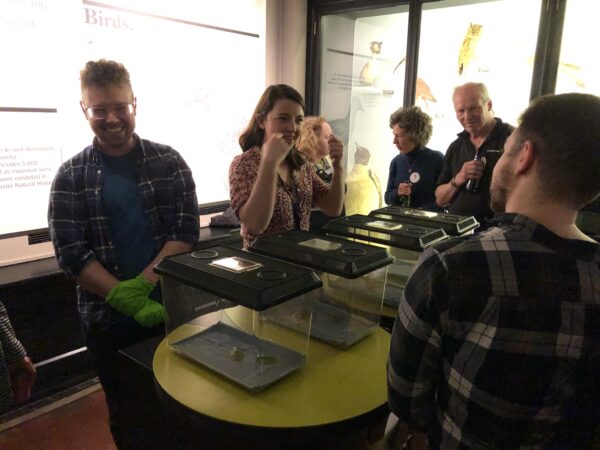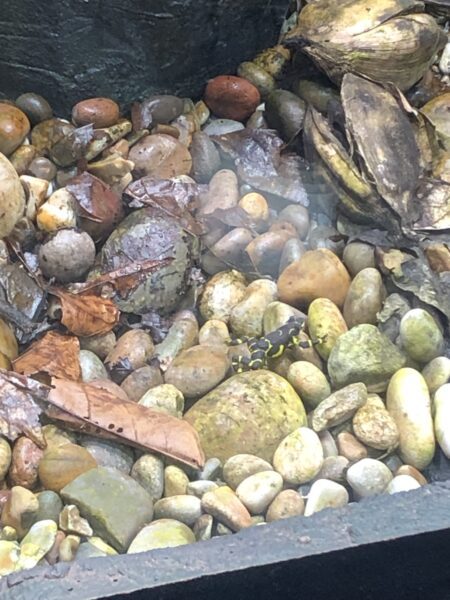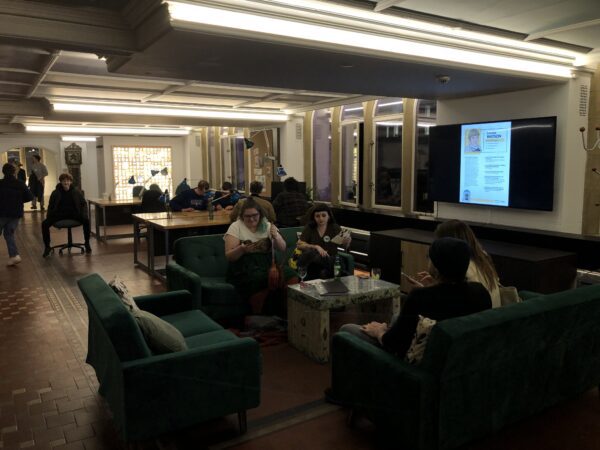Variable Harlequin Toads: Conservation at Manchester Museum

On March 22, Manchester Museum hosted an opportunity to learn directly from amphibian specialists about rare toads, accompanied by Central American music performed by Adrian Garcia’s Trio. From 6pm to 8:30pm, museum guests roamed freely around special interactive exhibitions in the Vivarium; origami workshops, and a networking event on the Top Floor.
Speeches to over 100 members of the public were given by Her Excellency Mrs Natalia Royo de Hagerman (the Panamanian Ambassador to the UK), Dr Luis Ureña (Director of Panama Wildlife Conservation Charity), Esme Ward (Director of Manchester Museum), and Matthew O’Donnell (Curator of Herpetology at Manchester Museum).

Panama x Manchester: Conservation across continents
Whilst Variable Harlequin Toads are only around 40mm in size, they have a huge significance in their local, tropical ecological systems. The toads originate from Panama and Costa Rica in Central America, but their population has experienced drastic declines in recent years and they are now classed as critically endangered.
Manchester Museum explained that “In 2019 we began recreating the exact conditions of the toad’s Panamanian habitat. In 2020, in a moment of triumph, the team found a cluster of eggs among the rocks in the tank. One of the world’s most endangered and beautiful toads had been successfully bred in Manchester Museum.”

“This success, and our brand-new exhibit of variable harlequin toads, is the result of an inspiring partnership project between Manchester Museum, the University of Manchester, and Panama Wildlife Conservation charity.”
Currently, all the Harlequin Toads in the Vivarium were born at Manchester Museum (making them Mancunian). They form part of a captive ‘safety-net’ established to help conserve this critically endangered amphibian, ensuring it will never become extinct.
Variable Harlequin Toads

These rare and colourful frogs inhabit remote tropical rainforests in Panama. The females live in the protective forest, whereas the males live by fast-flowing tropical streams.
Like many frog species, the males and females only come together to breed and do not otherwise interact with each other. At the museum only the males are on display in the Vivarium, with the females kept in a separate enclosure to prevent uncontrolled reproduction.
Variable Harlequin Toads are active during the day and communicate by calling and by slowly waving their hands. They eat a diet consisting of small insects and other invertebrates.
Female Harlequin Toads lay small white eggs in long strips attached to the underside of rocks in fast-flowing streams. When they grow up to become tadpoles, they have sucker-like mouthparts to feed on algae.
Natural Ecological Indicators
Matthew O’Donnell, the Curator of Herpetology at Manchester Museum, explained the importance of Variable Harlequin Toads for climate scientists.
“As these toads are so sensitive to tropical environments’ humidity, sunlight and food resources, they are natural ecological indicators.” Similar to how a canary is used to test for air quality in mines, the behaviour of the toads can be observed to indicate small environmental changes in remote forests where modern climate equipment can’t be used.
They are therefore essential to Panamanian scientists who are trying to preserve the country’s natural environment.
Manchester Museum Events
The Panama x Manchester conservation session was part of the Museum’s free late-night events that take place during their Wednesday evenings extended opening hours. Previous events include Iftar at the Museum and coming up on April 26 is Meet The Artists – The Singh Twins, where Amrit and Rabindra Kaur Singh will discuss their new work, ‘Rags to Riches, Riches to Rags’, in the museum’s South Asia Gallery.

Manchester Museum has also created a programme of workshops, activities, and Museum Lates events that are aimed at University students. For example, every Wednesday afternoon they host a free Nature and Nurture drop in session which is “a chance to meet other students, socialise, talk about what matters to you, and explore the museum. You will also be able to get involved in co-curating museum events, resources and projects with and for your peers, focusing on nature, wellbeing and environmental action.”
The Top Floor at Manchester Museum, an environmental action and social justice hub, hosts artists, writers and musicians in this creative space and is open to public visitors 2-4pm, Tuesday – Saturday.







